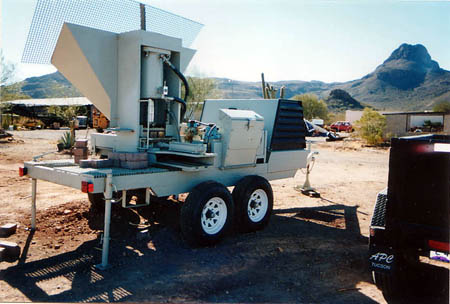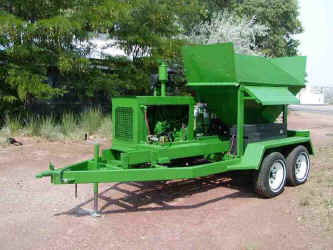The Vertical Press vs. The Horizontal Press
by Dan Powell
As the competition is heating up the claims of manufacturers about their products can cause a lot of confusion. So I am going to try to define the differences, the advantages, the liabilities and the uses of both the vertical block press and the horizontal block press.
First a little history.
Sometime in the Early 50's a Columbian inventor designed the first Cinva Ram. This was a hand operated device that allowed one man to produce 2 to 3 hundred blocks a day and install them immediately. This one machine alone has revolutionized the Earth Construction business. The elimination of drying time and the increase of strength of the block made this a very desirable product especially in poor rural areas. You can see an improved model of this and more modern versions at www.ferncometals.com .
Back in the early 70's there were a lot of different machines being developed and tested along with construction techniques. The Craterre organization had several machines (vertical) that they were using all over North Africa and in the Middle East. The information published as a result of their efforts has greatly enabled people all over the world in both the understanding of the machinery, the methods of construction and the credibility of the enterprise. In the Southwest U.S. several groups and individuals were also designing machinery and building homes. Many mistakes were made and as is common in a capitalistic society everybody tried to one up the other. This resulted in some pretty innovative designs and some pretty bad ones. Many were sold and are sitting in some ones yard as a testimony to their lost dreams and wasted money. We have a few of those, one we built and two we salvaged.
The names I am familiar with are of some in New Mexico who were active in this enterprise, some sold their designs and others have built a moderate business building earth block presses. John Wright of Grants N.M., Jim Honeycutt of Albuquerque N.M., David Leneau of Corrales N.M., Henry Elkins of Grants N.M., W.C. Powell of San Ysidro N.M.,
WC Powell describes some of this process in his publication The Learning Curve of Design at www.adobemachine.com/designing.htm.

Vertical Block Press 10 x 16 x 4 from Earth Uprising
The Vertical Block Press
PROS
-
Uniform block dimensions in wall sizes
-
Adaptability to cast adobe construction
-
Simple adaptive mold changes
-
Able to produce interlocking block
-
Fewer block imperfections
-
Produce quality block
-
Produce uniformly dense block
CONS
-
Irregular block thickness (+-4")
-
Require mortar to level
-
More expensive to build
-
Much larger structure to withstand pressures
-
Higher complexity of components
-
Higher center of gravity (less stable on roads)
-
Higher smaller hopper
-
Block sizes limited to mold changes
-
Heavier, more expensive to ship
-
Requires a manicured soil
Why The Difference
There were five major issues that drove the conversion from the vertical press to the horizontal.
1 Feeding the mold with a uniform amount of materials.
2 The structure required to withstand the tonnage developed during the press cycle.
3 The height requirements of both the hopper and the ejected block.
4. Costs of the components.
5. Complexity of design and components.
This wasn't easy to do because at the time dry stacking wasn't allowed and the New Mexico standard block size was 10" x 14" x 4" and the standard wall thickness was 10". So there was no advantage to go to a horizontal press except for the ability to overcome those five basic issues.
A vertical press presses from the top or bottom of the block. if the block is 10 x 14 then the press area is on the 10 x 14 side, 140 sq in at 1500psi is 105 tons of force on the press structure.
The resulting block is perfectly 10 x 14 but the thickness is not perfect, in order to maintain a uniformly thick block and uniform density between blocks the soils in each block would have to be identical in both volume of soil and moisture content, not possible. This irregularity is the same as that experienced by cast adobe and the cure is a mortar bed to level the blocks. that adds another expense as well as requiring a higher level of skill in the building process. However you can build either 10" or 14" walls.
A horizontal press presses the block from the 4 x 14 end. this is 56 sq in at 1500 psi = 42 tons of force on the press structure.
The resulting block is a perfect 4 x 14 x 2 to 12 inches, or a 4 x 12 x 2 to 8 ", which you can determine by the simple slide of a limit switch. but that last dimension is never perfect for the same reason BUT you can dry stack a wall about 4 times faster and with much less cost using basic skilled labor. So we think that is a pretty good trade off.
Most of the people I have talked to that use a vertical press are targeting the ADOBE client which is high end, labor intensive, and architecturally challenging. We can do that, witness the home shown on Midwest Earth builders for the DeHaan family in Pella Iowa with a PDA-480-14dp, But dry stacking is best suited for production building. You can, with 10 people on site and the PDA-480-14dp produce and build (the walls) the equivalent of a 1200 square foot home a day. You can't do that with a mortared system in 4 days because the mortar has to dry.

Horizontal Block Press 4" x 14" x 2" to 12" Powell & Sons
The Horizontal Block Double Press
PROS
-
Uniform block sizes in construction dimensions
-
Uniformly dense block
-
Inexpensive off the shelf components
-
Lower center of gravity, easy to tow at speed
-
Lower hopper and block ejection
-
Simpler components and construction
-
Block thickness is uniform allowing for dry stacking
-
Press structure is lighter
-
Quick block size adjustments by sliding a switch
-
Less expensive
-
Can make a decent block from raw moist soil in most cases
CONS
-
Does not adapt easily to cast adobe sizes
-
Mold size changes are difficult
-
Block lengths are imprecise
-
Can not produce interlocking block